Esteban de Bilbao Eguía
The Marquess of Bilbao Eguía | |
|---|---|
 Pictured in 1916 | |
| President of the Cortes | |
| In office 16 March 1943 – 29 September 1965 | |
| Preceded by | Diego Martínez Barrio as president of the Republican Courts (1936-1939) |
| Succeeded by | Antonio Iturmendi Bañales |
| Minister of Justice | |
| In office 9 August 1939 – 16 March 1943 | |
| Preceded by | Tomás Domínguez Arévalo |
| Succeeded by | Eduardo Aunós |
| Personal details | |
| Born | Esteban de Bilbao Eguía 11 January 1879 Bilbao, Spain |
| Died | 23 September 1970 (aged 91) Durango, Spain |
| Political party | Comunión Tradicionalista, Falange Espanola Tradicionalista |
| Occupation | lawyer, politician |
Esteban de Bilbao Eguía, 1st Marquess of Bilbao Eguía (11 January 1879 – 23 September 1970), was a Spanish politician during the dictatorship of Francisco Franco.
Family and youth
[edit]
Esteban Martín Higinio de Bilbao Eguía[1] was born into a Basque middle-class bourgeoisie family. His paternal grandfather, Manuel Bilbao, ran a merchant business in his native town of Guernica in Biscay province.[2] One of Manuel's sons became a presbyter,[3] while another, Hilario Bilbao Ortúzar, moved to Bilbao and practiced as a physician.[4] Hilario married María Concepción Matea de Eguía Galindez, a descendant of a distinguished and widely branched Biscay family.[5] The couple had six children, with Esteban[6][7] All of the Bilbao Eguía children were raised in a fervently Catholic environment, though none of the sources consulted provides any information on the political preferences of their parents.
The young Esteban was first educated at the Instituto Provincial, the local state-run secondary school in Bilbao.[8] Sources provide varying details of his exact academic path, though most agree that he studied law and philosophy, initially at the Jesuit University of Deusto in Bilbao, later moving to the prestigious Universidad de Salamanca, where he completed both curricula.[9] Bilbao crowned his academic career by earning a PhD in law from the Universidad Central of Madrid.[10] After returning to his native Biscay, he opened a law office and,[11] in 1904, was registered as a practicing abogado (lawyer) in Bilbao.[12] In 1913, he married María de Uribasterra e Ibarrondo (1891–1976).[13] The couple had no children.[14]
Early public activity
[edit]
It is unclear whether Bilbao inherited his Carlist outlook from his forefathers or whether he embraced it during his academic years. By 1902, he was already firmly established in the local Biscay structures of mainstream Carlism, and alongside national figures like Juan Vázquez de Mella, he toured the province, organizing meetings and delivering speeches.[15] In 1904, he ran as a Carlist candidate[16] in the elections for the Bilbao City Council and was successful;[17] some sources suggest that he was later appointed as teniente de alcalde (deputy mayor).[18] When he objected to the presence of a Protestant minister at an official municipal event,[19] the government charged him with breaching the constitution and canceled his mandate.[20]
In his pursuit of Catholic militancy against the increasing secularization promoted by Madrid governments, Bilbao played a pivotal role in the Biscay branch of Juventud Católica.[21] He also actively participated in various other local Catholic initiatives, such as representing Carlism at public meetings opposing secular schools.[22] His activities reached their peak at the turn of the decade during the public uproar caused by the so-called Ley del Candado. As a member of the Biscay Junta Católica, he took part in countless gatherings and events, the most notable being the Acto de Zumárraga in 1910.[23] Some of his speeches skirted the edge of legality, leading to him being tried three times, though the outcomes of these trials are unknown.[24]
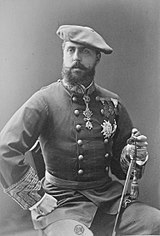
Within the Traditionalist ranks, Bilbao, along with fellow Deusto students Victor Pradera and Julio Urquijo, formed a new generation of activists. They were promoted by the claimant Carlos VII and the party leader, Marqués de Cerralbo, in their effort to build a modern Carlist network.[25] In 1907, Bilbao was fielded as the official party candidate to the Cortes from the Álavese district of Vitoria. His debut turned into a fratricidal conflict, as another Carlist, Enrique Ortiz de Zarate, ran with the backing of the youth and a more militant electorate;[26] as a result, both Carlists lost.[27] In 1910, there were rumors that Bilbao would replace Vázquez de Mella as the Jaimist candidate in Pamplona, Navarre, but in the end, it was the latter who stood and won.[28] In the subsequent 1914 campaign, Bilbao ran in his native Biscay, in Durango, but lost again, this time to the conservative candidate José de Amézola y Aspizua.[29] The loss led to riots between supporters of both candidates.[30]
Bilbao embraced Basque identity in the Carlist tradition, viewing local provincial fueros and ethnic identity as indispensable elements of the broader Spanish political nation. He participated in the first Congreso de Estudios Vascos,[31] where he had the honor of delivering the closing address. In his speech, he expressed solidarity with the persecuted "madre Euskal Herria" and advocated for the establishment of a Basque university to lead the "restauración cultural vasca" (Basque cultural restoration).[32] He remained active in subsequent congresses until the late 1920s, playing a vital role in its Sección de Estudios Sociales.[33] His interest in social issues extended beyond the Basque realm,[34] as evidenced by his publication of the leaflet "La cuestión social."[35]
Cortes and Asamblea Nacional
[edit]After unsuccessful electoral campaigns in Álava, Navarre, and Biscay, Bilbao competed in 1916 in the Carlist national stronghold, the Gipuzkoan district of Tolosa. He defeated the conservative candidate[36] and became part of the 9-member Jaimist minority in the Cortes. In 1918, he ran again in the same district and was re-elected.[37] Known for his active defense of the Church, religion, and Traditionalism,[38] Bilbao distinguished himself as one of the most notable Carlist orators,[39] though some critics described his style as having a penchant for purple rhetoric.[40]
During the Mellista crisis, Bilbao remained loyal to the successive claimant, Don Jaime,[41] and worked closely with him, even editing some of his proclamations and documents.[42] As the secession decimated the Jaimist ranks, Bilbao became the local Biscay jefe.[43] In 1919, he was fielded as the provincial Jaimist candidate for the Senate.[44] Elected, he remained active, focusing on syndical laws and the autonomous status of universities.[45] It is unclear why he abandoned his senatorial position in 1920 to run for the Cortes again, but this time, he returned to Navarre and was elected from another Carlist stronghold, the Estella district.[46] In 1923, during the last parliamentary campaign of the Restoration, the Carlist king ordered abstention, and no official candidates were fielded.[47]
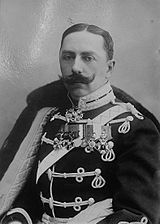
Though most Carlists initially welcomed the Primo de Rivera coup, viewing it as a stepping stone toward a traditionalist, anti-democratic monarchy, their sympathy soon waned. Don Jaime eventually instructed his followers not to participate in the primoderiverista institutions. However, Bilbao ignored this directive and became one of the most vocal advocates of the dictatorship.[48] In 1924, he joined the new state party, Unión Patriótica.[49] By 1926, he was appointed president of the Diputación de Bizkaia,[50] a position he held for four years, during which he worked to negotiate the provincial concierto económico.[51] In 1927, he joined the newly appointed quasi-parliament, the Asamblea Nacional Consultiva[52] as a representative of the diputaciones provinciales.[53]
It is unclear which of these actions was the final straw, but Don Jaime and his political representative in Spain, Marqués de Villores, remained firm and expelled Bilbao from the Carlist ranks.[54] Despite this, Bilbao retained his Carlist identity and aligned himself with the Mellista branch of Traditionalism.[55]
He also remained active as a Catholic politician, heading the Biscay section of Acción Católica from the early 1920s.[56] He later participated in the first national congress and delivered an address.[57] In 1929, he attempted to launch a new Catholic political grouping, but the initiative failed to gain traction, receiving only a lukewarm reception from the primate Segura.[58] During the Dictablanda period, Bilbao reached out to the orphaned monarchist primoderiveristas from Unión Monárquica Nacional, speaking at their public meetings.[59]
Republic
[edit]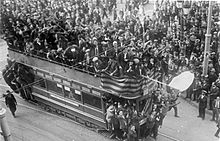
Sources provide contradictory information about Bilbao's relations with mainstream Carlism after the fall of the monarchy. Some authors claim that, although many Carlists believed the rise of the militantly secular Republic necessitated the unification of various Traditionalist branches, Bilbao was not enthusiastic about returning under Don Jaime's command.[60] Other scholars argue that by April 1931, he had already edited the claimant's proclamation, which instructed the Carlists to help maintain order and stay vigilant against the threat of foreign-inspired tyranny.[61] Additionally, there are conflicting reports that in late 1931 and early 1932, Bilbao attempted to broker a failed dynastic agreement with the deposed Alfonso XIII.[62]
Following the unexpected death of Don Jaime, Bilbao resolved any doubts he might have had and, alongside Pradera, led the Mellistas into the united Carlist organization, Comunión Tradicionalista. He became the head of its Biscay section[63] and joined the national Junta Suprema.[64] He established a close working relationship with the new claimant, Don Alfonso Carlos, co-editing several of his proclamations and documents,[65] including those that seemed to confirm the late Don Jaime's policy of opening dynastic negotiations with the Alfonsinos.[66] Bilbao himself was inclined towards a dynastic pact and is listed as one of the so-called "transaccionistas."[67] He engaged in the monarchist alliance and contributed to Acción Española.[68] Some sources claim he joined the manifesto launching a new broad alliance, Bloque Nacional,[69] while other authors maintain that he was one of the few leaders who did not sign it.[70]
From the outset, Bilbao contributed to the Carlist military buildup. In the summer of 1931, he was in touch with the Comité de Acción Jaimista, an organization established to gather vigilantes for protecting religious buildings.[71] He agreed to join the monarchist military junta, to be led by General Emilio Barrera. In October 1931, he was briefly detained and,[72] in early 1932, was sentenced to two months of exile in Navia de Suarna (Lugo province).[73] He was at least aware of, and possibly involved in, the Sanjurjo coup,[74] although the authorities did not identify him as complicit. His opposition to the dissolution of the Jesuit order and the enforcement of secular schools led to further detentions and two court trials.[75]
In 1933, Bilbao resumed his parliamentary duties as a Carlist deputy from Navarre.[76] He later defended the traditional Navarrese fueros,[77] although he opposed the autonomy of Catalonia.[78] That same year, alongside other party figures like Jesús Comín, he joined the 18-member Council of Culture. Although the council had little power, it brought together Carlists of different origins and bolstered the new leadership of Manuel Fal Conde.[79] In 1935, Bilbao reached the highest level of the Carlist executive when he joined the 5-member Council of the Comunión.[80] Within the already militant and fervently anti-Republican Traditionalist camp, Bilbao led an even more hawkish faction. He refused to stand in the 1936 elections due to his self-proclaimed hatred of parliamentarism.[81]
Civil War
[edit]
It is unclear how Bilbao contributed to the military conspiracy or what his position was in the Carlist debates regarding their involvement in the rebellion. During the July 1936 coup, he was at his summer home in Durango.[82] Detained by the Basque authorities on the Altunamendi ship,[83] he was exchanged in late September for the Bilbao mayor, Ernesto Ercoreca, thanks largely to the efforts of Marcel Junod.[84] He then made his way via France to the Nationalist zone.[85] Bilbao joined the Junta Nacional Carlista de Guerra and was appointed a member of its Sección Política,[86] settling near the Cuartel General del Generalísimo in Salamanca.[87]
Starting in late 1936, Carlism was increasingly paralyzed by its unclear governing structure and political indecision, especially when faced with pressure from Franco and his chief aide, Ramón Serrano Suñer. As a member of the Carlist executive, Bilbao participated in some meetings in early 1937, which were called to discuss the looming threat of amalgamation into a future state party. During the Insua gathering,[88] he was not under the illusion that the new regime would resemble the mild dictatorship of Primo de Rivera; he seemed aware of Franco's centralist, anti-regionalist agenda and warned against a "gobierno definitivo de tipo falangista"[89] and a regime that was "fuerte, dictatorial y cesarista."[90] Despite this, he tended to hesitantly accept the perspective of unification, albeit against the intransigent faction of Fal.[91] The semi-rebellious Carlist body, the Junta Central Carlista de Guerra de Navarra, pursued an appeasement strategy and tried to assume a leading role within the movement by suggesting a reorganization of Carlism, with Bilbao proposed to lead its Sección Política.[92] However, these plans were ultimately thwarted as Franco pressed for action and soon declared his Unification Decree.
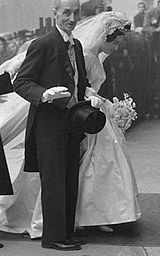
Faced with a choice between compliance with Rodezno and the intransigence of Fal, Bilbao aligned himself with Francoist unification and joined the newly established FET.[93] Although he was not among the four Carlists who entered the first 10-member Secretariado of the party,[94] in October 1937, he was nominated as one of 12 Traditionalists to the entirely decorative 50-member Consejo Nacional.[95] Despite vehement objections from Fal Conde, Bilbao remained steadfast and,[96] in December 1937, the new regent-claimant Don Javier and Fal agreed to expel him from the Comunión.[97] With all bridges burned, and following the transformation of the Secretariat into the Junta Politica, Bilbao emerged as one of the two top-positioned Carlists in the regime, becoming a member of the Junta in October 1939. He had little, if any, influence on the emerging party, as its Estatuto and internal structures were designed by Serrano,[98] who—together with his Falangist entourage—became Bilbao’s chief opponent.[99] Bilbao rather excelled as a speaker, mobilizing support at public events in Vascongadas.[100]
Minister of Justice
[edit]
In 1938, Bilbao became president of the Comisión de Codificación within the Francoist Ministry of Justice and began working on the development of the Francoist legal code.[101] When his fellow Carlist, Conde Rodezno, left the ministerial position, Bilbao replaced him in August 1939 and held the post until 1943.[102] As Minister of Justice, he presided over one of the most repressive legal systems in modern Europe.[103]
In terms of judicial executions, early Francoist Spain surpassed Nazi Germany and was second only to the Soviet regime.[104] The number of death penalties handed down in the few years following the Civil War was 51,000,[105] though nearly half were commuted by Franco, resulting in approximately 28,000 executions.[106] When Bilbao assumed the ministry, he oversaw the greatest single wave of incarcerations, increasing the number of political prisoners from 100,000 at the end of the Civil War to 270,000 by the end of 1939.[107] In the following years, this number decreased steadily due to a series of amnesties,[108] and by the time he left the ministry, he admitted to 75,000 political prisoners.[109] Meanwhile, thousands of these prisoners died in overcrowded prisons.[110] Although labor camps remained under military control, his ministry provided juridical assistance, resulting in about 90,000 people working under atrocious conditions in penal detachments.[111] The brutality of the system even shocked Heinrich Himmler.[112]
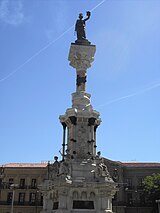
Bilbao coordinated work on the Francoist repressive legislation, including its cornerstones: the Ley de Responsabilidades Políticas (1939),[113] the Ley de Represión de la Masonería y Communismo (1940),[114] and the Ley de Seguridad del Estado (1941).[115] He developed the appropriate juridical organization, such as establishing the Tribunal Especial para la Represión de la Masonería y el Comunismo.[116] As minister, he contributed to the legal framework for the so-called niños robados,[117] the Patronato Central de Redención de Penas por el Trabajo (which covered approximately 10,500 children in 1943),[118] and the Patronato de Protección a la Mujer.[119] Under his guidance, the divorce and marriage legislation of the Republic was retroactively reversed.[120]
While Bilbao defended local fueros as head of the Biscay Diputación during Primo de Rivera's dictatorship, there is no information about his stance on the Francoist political penalties applied to Biscay and Gipuzkoa, which were labeled "provincias traidoras" and stripped of any remnants of separate local establishments, including the concierto económico.[121] However, Bilbao claimed to have defended the Navarrese fueros and to have prevented efforts by the Ministry of Economy to impose homogenization measures on the province.[122]
Dignitary
[edit]As Minister of Justice and the regime's top lawyer, Bilbao shaped the Ley Constitutiva de las Cortes (1942). According to this law, he was entitled—both as a member of the Consejo Nacional and as a minister—to enter the Francoist quasi-parliament when it first assembled in 1943. To balance various political groupings, Franco awarded the speaker role to the Carlists and handpicked Bilbao for the position.[123] He held this role for 22 years, serving in 1946, 1949, 1952, 1955, 1958, 1961, and 1964,[124] until he resigned in 1965 due to his age.[125] During his tenure, approximately 4,000 laws were adopted.[126] As Presidente de las Cortes, Bilbao held one of the most prestigious positions in Francoist Spain, though it carried very little political power. As one of the top Carlists within the regime,[127] he was expected to represent Traditionalist roots and a broad political adherence to the regime.
Having served for 35 years in the Restauración parliament, the Primo de Rivera Asamblea Nacional, the Republican Cortes, and the Francoist Cortes Españolas, Bilbao remains the longest-serving Spanish deputy of the 20th century and one of the longest-serving Spanish MPs ever.[128] His first and last days in the chamber spanned 49 years, a record in Spanish parliamentary history.[129]
In 1947, Bilbao was a key author of the Ley de Sucesión,[130] the law that officially established Spain as a monarchy and created a vague pathway for royal restoration while simultaneously solidifying Franco's rule as Jefe de Estado. This law was protested by both Alfonsist and Carlist claimants, Don Juan and Don Javier.[131] According to the law, Bilbao, by virtue of his role as parliament speaker, entered two newly established bodies: the Consejo del Reino[132] and the Consejo de Regencia.
The Consejo del Reino, a unique diarchic structure for an authoritarian monarchy proposed earlier by Primo de Rivera, was designed as a special deputy to the executive. It was meant to assist the Head of State on matters within his exclusive competence and was presided over by Bilbao.[133] The Consejo de Regencia, composed of three officials, was intended to act as an interim regency during the transition to Franco's successor or in his absence. The Consejo de Regencia functioned for only nine days in October 1949, during Franco's one and only foreign trip after the Civil War.[134]
Relations with Falangism
[edit]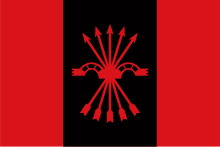
During his 30 years of activity within the Francoist regime, Bilbao maintained a perfectly loyal stance.[135] He is credited with coining the royally-sounding phrase "Francisco Franco, Caudillo de España por la gracia de Dios."[136] There is no evidence that he participated in any conspiracy, opposition, or protest against Franco personally. His political efforts were primarily focused on keeping the hardline Falangists at bay, occasionally combined with a rather timid advocacy of the monarchist idea.
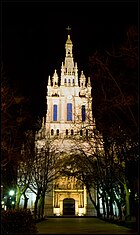
In the summer of 1940, Ramón Serrano Suñer proposed the Ley de Organización del Estado, a draft aimed at giving Falange a central role in the totalitarian new structure. This plan elicited a letter of protest from Bilbao, who denounced the "systematic interjection of the party" into state organs. The dissent was shared by most monarchists and parts of the army, leading to the shelving of the project and an evolution of the Francoist system along more hybrid lines.[137]
Discontent between the Falange diehards and the monarchists prompted Bilbao to resign as a minister in early August 1942. However, he changed his mind after receiving a flattering letter from Franco.[138] Shortly thereafter, the Begoña incident led to a showdown between the Carlists and the Falangists, with General Varela demanding that Falange be brought into line and the process of monarchy restoration begin.[139] Bilbao supported Varela, but Franco outmaneuvered the dissidents, convincing them to comply.[140] This standoff eventually led to the sidelining of Serrano and a de-emphasis of Falangism.[141]
The last major confrontation between syndicalist hardliners and monarchists occurred in late 1956. Bilbao compared Arrese's draft of the Leyes Fundamentales to "Soviet totalitarianism" and led a coalition of monarchists, the Catholic hierarchy, and the military against the project.[142] The confrontation resulted in a cabinet reshuffle, the sidelining of Arrese, and a shift in power to the technocrats.
Due to his age, Bilbao became a somewhat decorative figure starting in the late 1950s. In 1965, he resigned from all political functions, citing his declining years.[143] As a private retiree, he could afford more frankness, and as late as 1969, he publicly expressed a barely veiled lack of enthusiasm for the perceived Falangist domination in the Cortes, both during his presidency and afterward.[144]
Relations with Carlism
[edit]
Following his expulsion from the Comunión, Bilbao's relations with mainstream Carlism were reduced to nil. When, in late 1942, the Carlists abandoned any hopes of preserving their identity within the FET, Fal Conde declared that those previously expelled might be readmitted provided they sever any links with Falange. However, Bilbao was explicitly excluded from this scheme.[145]
Lambasted by mainstream Carlists as a double traitor who had already abandoned Don Jaime in the 1920s,[146] Bilbao even faced minor snubs in the Cortes.[147] He did not join the Reclamación del poder, a protest letter signed by the Javieristas and delivered to Franco in 1943.
Though Don Javier counted Bilbao among the "camaradas" of the treacherous Rodezno, Bilbao did not follow Rodezno's approach of aligning with Don Juan as the legitimate Carlist claimant.[148] Instead, in 1943, together with other Traditionalists like Joaquín Bau, Iturmendi, and del Burgo, he re-launched[149] the candidacy of Archduke Karl Pius of Austria, Prince of Tuscany, styled as Carlos VIII.[150] Within the limits permitted by the Francoist regime, he cautiously supported Carloctavismo[151] until the claimant's unexpected death in 1953.[152]
When, in the mid-1950s, Carlism shifted its strategy from opposition to cautious collaboration with Francoism, the distance between Bilbao and the party diminished. The new generation of Carlist activists, particularly the young anti-Traditionalist entourage of Don Javier's son, Carlos Hugo, sought to use Bilbao in their bid for power.[153] Despite despising him as a traitor,[154] in 1959 they invited him to join the Junta Directiva Central, a front-office organization supporting their semi-political initiatives, such as Círculos Culturales Vázquez de Mella and the periodical Azada y asta.[155]
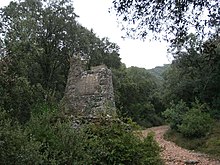
Most likely, the senile Bilbao was unaware of the power struggle already prevalent within Carlism, where reactionary Traditionalists were confronted by the socialist Progressists. In 1963, as the Cortes speaker, he sent a greeting telegram to the Carlist annual gathering at Montejurra, which at the time served as a key event in the Huguista bid for power and as a promotional stage for Carlos Hugo himself.[156]
Already a political retiree and faced with the prospect of Juan Carlos being declared the future king, in 1969 Bilbao remarked that it would not be intelligent to stumble twice over the same stone.[157] A year before his death, he voiced support for Don Javier.[158] The only notable Carlist present at his funeral was José Luis Zamanillo.[159]
Other, reception and legacy
[edit]
Bilbao was a member of several juridical bodies, including the Real Academia de Jurisprudencia, which he led from 1946;[160] the Real Academia de Ciencias Morales y Políticas;[161] and the Sección de Ciencias Jurídicas de la Academia de Bilbao.[162] Although he did not pursue an academic career, Bilbao served as a temporary professor of law at the Universidad Libre de Vizcaya.[163] He also presided over the Asociación de Antiguos Alumnos de la Universidad de Deusto.[164] In 1947, he was awarded the title of Hijo Predilecto by the Bilbao Ayuntamiento[165] and the title of Hijo Benemérito by the Diputación de Vizcaya.[166] In 1955, he was named honorary mayor of Durango.[167]
Though not widely recognized as a theorist or author, Bilbao wrote several works spanning various fields. His publications include history (e.g., La cuestión social [Aparisi y Guijarro, 1941]), philosophy of law (La idea del orden como fundamento de una filosofía política, 1945), history of law (Jaime Balmes y el pensamiento filosófico actual, 1949), and theory of law (La idea de la justicia y singularmente de la justicia social, 1949; De la persona individual como sujeto primario en el Derecho Público, 1949; De las teorías relativistas y su oposición a la idea del derecho romano, 1953).[168] He also contributed to various newspapers and periodicals, including Diario de Navarra, El Fuerista, El Diario Vasco, El Pueblo Vasco, El Correo Español, La Gaceta del Norte, El Pensamiento Navarro, and El Día.[169]
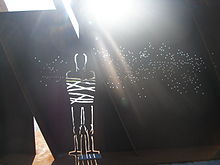
Bilbao was awarded the Gran Cruz de la Orden de Isabel la Católica[170] and decorated with the Gran Cruz de Carlos III, Gran Cruz del Mérito Naval, Cruz Meritísima de San Raimunde do Peñafort, and Gran Cruz de la Orden Plana.[171] In 1961, he was granted the title of Marquess of Bilbao Eguía (es: Marqués de Bilbao Eguía),[172] which passed to his brother, Hilario, upon his death.[173] In 2006, the Audiencia Naciónal, the Spanish high court, attempted to formally acknowledge Bilbao as guilty of crimes against humanity.[174] However, due to procedural issues, this initiative did not succeed. In contemporary Spanish public discourse, he is sometimes referred to favorably as "Vasco de leyenda"[175] or neutrally as "en cierto modo el espécimen del político vasco ultraconservador."[176] More frequently, he is highly criticized as "franquista"[177] or "fascista."[178] Leftist political groups have called for his portrait to be removed from the Spanish Cortes, where it is currently displayed.[179] To date, Bilbao has not been the subject of a full-scale biography or any smaller work.[180]
See also
[edit]Footnotes
[edit]- ^ not to be confused with a contemporary Basque trotskyist, Esteban Bilbao (?-1954), see marxist.org service available here
- ^ see the official service of Spanish senate, available here
- ^ El Siglo Futuro 07.06.13, available here
- ^ see euskalnet service, available here
- ^ Eguia family explained in detail here
- ^ according to the birth certificate he was born in Bilbao, see here; some sources claim he was born in Durango, see Idioia Estornés Zubizarreta, Esteban Bilbao Eguía entry [in:] Auñamendi Eusko Entziklopedia online, available here
- ^ see Geneallnet service available here
- ^ Gonzalo Díaz Díaz, Hombres y documentos de la filosofía española, vol. 1, Madrid 1980, ISBN 8400047265, 9788400047269, p. 591; according to another source, it was "Instituto general y tecnico", El Imparcial 16.05.28, available here2
- ^ according to Estornés Zubizarreta, Esteban Bilbao Eguía entry, he studied derecho and filosofia y letras at Deusto; according to Entrevista a Esteban Bilbao, [in:] Esfuerzo común 102 (1969), quoted after elcaballerodeltristedestino blog available here he studied filosofia y letras at Deusto, then moved to Salamanca where he graduated in law; according to Díaz Díaz 1980, p. 591 he studied filosofia and derecho at Deusto, but graduated in both in Salamanca
- ^ Entrevista a Esteban Bilbao, [in:] Esfuerzo común 102 (1969)
- ^ which in the mid-1920s would briefly employ the Basque political leader, José Aguirre, see Carlos Puerta Sesma, José Antonio Aguirre. Unidad didactica para la ESO, Donostia 2004, p. 10
- ^ Anuario Riera 2 (1904), p. 1695 available here
- ^ the spelling of her apellido is somewhat confused. When informing about the marriage, El Siglo Futuro 07.06.13 wrote "Urisbasterra", see here; when publishing her obituary, ABC 14.09.76 wrote "Uribasterra", see here, and this is the version repeated in almost all other works
- ^ see Geneallnet service available here; the euskalnet service wrongly claims that he fathered Hilario de Bilbao Eguía y Uribasterra, who was in fact Esteban's brother, see here
- ^ ABC 24.09.70, available here
- ^ from the Santiago quarter, ABC 24.09.70
- ^ Estornés Zubizarreta, Esteban Bilbao Eguía entry at Auñamendi Eusko Entziklopedia online
- ^ Entrevista a Esteban Bilbao, [in:] Esfuerzo común 102 (1969); the same version is presented in El Imparcial 16.05.28, available here
- ^ namely cornerstone laying ceremony to monument of Juan Crisóstomo de Arriaga, ABC 24.09.70
- ^ Javier Sánchez Erauski, El nudo corredizo: Euskal Herria bajo el primer franquismo, Tafalla 1994, ISBN 8481369144, 9788481369144, p. 213
- ^ El Siglo Futuro 08.10.11, available here, also El Siglo Futuro 05.11.12, available here
- ^ Cristóbal Robles, Cristóbal Robles Muñoz, José María de Urquijo e Ybarra: opinión, religión y poder, Madrid 1997, ISBN 9788400076689, p. 233
- ^ see the manifesto published at nodulo.org service, available here
- ^ ABC 24.09.70; see also Robles, Robles Muñoz 1997, p. 252
- ^ José Luis Orella Martínez, El origen del primer catolicismo social español [PhD thesis at Universidad Nacional de Educación a Distancia], Madrid 2012, p. 223; in 1910 Bilbao was already president of the local Circulo Tradicionalista, see Robles, Robles Muñoz 1997, p. 246
- ^ even the Catholic hierarchs remained divided between the two, see Onésimo Díaz Hernández, La "Ley del Candado" en Alava, [in:] Sancho el Sabio 11 (1999), pp. 151-2
- ^ Díaz Hernández 1999, p. 152
- ^ La Epoca 01.05.10, available here
- ^ La Epoca 09.03.14, available here; Amézola was the 1900 Olympic pelota champion (the only one in history, since pelota was later withdrawn from the olympic games), see olimpismo blog available here
- ^ El Heraldo de Madrid 09.03.14, available here
- ^ in 1918, Estornés Zubizarreta, Esteban Bilbao Eguía entry at Auñamendi Eusko Entziklopedia online
- ^ the address was delivered in castellano, Javier G. Chamorro, Bitarte: humanidades e historia del conflicto vasco-navarro : fueros, constitución y autodeterminación, Donostia 2009, ISBN 8461307119, 9788461307111, p. 209
- ^ Estornés Zubizarreta, Esteban Bilbao Eguía entry at Auñamendi Eusko Entziklopedia online
- ^ El Imparcial 16.05.28, available here
- ^ in 1920, ABC 24.09.70
- ^ see the official Cortes service, available here
- ^ see Cortes service here, see also the official deputy certificate available here
- ^ "Esteban Bilbao planteó que sólo existía la escuela socialista, la liberal y la cristiana. Las dos primeras creaban desorganización al centrarse en el Estado o en el individuo. Por eso el orador subrayaba la importancia de la Religión la única que conseguía la unidad de la humanidad bajo la luz de la solidaridad, y el problema social es principalmente un problema de solidaridad", Orella Martínez 2012, p. 223
- ^ Orella Martínez 2012, p. 223
- ^ Stanley G. Payne, The Franco Regime, Madison 2011, ISBN 0299110745, 978-0299110741, p. 235
- ^ Estornés Zubizarreta, Esteban Bilbao Eguía entry at Auñamendi Eusko Entziklopedia online
- ^ Entrevista a Esteban Bilbao, [in:] Esfuerzo común 102 (1969)
- ^ Orella Martínez 2012, p. 223
- ^ Estornés Zubizarreta, Esteban Bilbao Eguía entry at Auñamendi Eusko Entziklopedia online
- ^ see the official Senate service available here
- ^ see the official Cortes service available here
- ^ ABC 13.03.1923
- ^ Estornés Zubizarreta, Esteban Bilbao Eguía entry at Auñamendi Eusko Entziklopedia online
- ^ Josep Carlos Clemente, Carlos Hugo: La Transición Política Del Carlismo: Documentos, 1955-1980, Madrid 2000, ISBN 9788480100786, p. 33, Orella Martínez 2012, p. 223
- ^ Díaz Díaz 1980, p. 591, see also Guía oficial de España 1927, p. 661, available here
- ^ Esteban Bilbao Eguia entry [in:] Concierto economico website, available here Archived 2015-04-02 at the Wayback Machine
- ^ Estornés Zubizarreta, Esteban Bilbao Eguía entry at Auñamendi Eusko Entziklopedia online, also Entrevista a Esteban Bilbao, [in:] Esfuerzo común 102 (1969)
- ^ see Cortes service here
- ^ Don Jaime had no problem with dictatorial nature of Primo's regime; he despised it when realized that Primo intended to support the Alfonsine monarchy. This led some authors to conclude that by accepting primoderiverista posts, Bilbao betrayed Carlism and moved to the Alfonsine camp, see José Carlos Clemente Muñoz, El carlismo en el novecientos español (1876-1936), Madrid 1999, ISBN 8483741539, 9788483741535, p. 168, the charge repeated also in Carlist propaganda of the 1950s
- ^ Martin Blinkhorn, Carlism and Crisis in Spain 1931-1939, Cambridge 2008, ISBN 9780521207294, 9780521086349, p. 72; some sources suggest that Bilbao sympathised with the Mellists already during their secession, see Manuel Martorell-Perez, Nuevas aportaciones históricas a la evolución ideológica del carlismo, [in:] Gerónimo de Uztariz, 16 (2000), p. 104
- ^ the post he retained until 1933, Juan José Alzugaray Aguirre, Vascos relevantes del siglo XX, Donostia 2004, ISBN 9788474907339, p. 71
- ^ in 1930; Santiago Martínez Sánchez, El Cardenal Pedro Segura y Sáenz (1880-1957) [PhD thesis Universidad de Navarra], Pamplona 2002, p. 168
- ^ Martínez Sánchez 2002, p. 129
- ^ Robles, Robles Muñoz 1997, p. 415
- ^ Blinkhorn 2008, p. 72
- ^ Eduardo Gonzales Calleja, Contrarrevolucionarios, Madrid 2011, ISBN 9788420664552, p. 66; some consider it a reference to the Soviet Russia, some to the exiled Alfonso XIII
- ^ Galindo Herrero, Los partidos, Madrid 1954, Blinkhorn 2008, pp. 85, 324-5
- ^ Sánchez Erauski 1994, p. 213
- ^ Julio Aróstegui, Eduardo Calleja, La tradición recuperada: El requeté carlista y la insurrección, [in:] Historia Contemporanea 11 (1994), p. 35
- ^ Entrevista a Esteban Bilbao, [in:] Esfuerzo común 102 (1969), Gonzales Calleja 2011, p. 77
- ^ Gonzales Calleja 2011, p. 77
- ^ Aróstegui, Calleja 1994, pp. 35-66
- ^ Carlos Pulpillo Leiva, Orígenes del franquismo: la construcción de la "Nueva España" (1936–1941), [PhD thesis Universidad Rey Juan Carlos], Madrid 2013, p. 169
- ^ Maximiliano Garcia Venero, Historia de la Unificacion, Madrid 1970, p. 72
- ^ Blinkhorn 2008, p. 190
- ^ Gonzales Calleja 2011, pp. 69-70
- ^ ABC 17.11.31 available here
- ^ Josep Carlos Clemente, Breve historia de las guerras carlistas, Madrid 2011, ISBN 8499671705, p. 231, Blinkhorn 2008, p. 77; some sources claim the exile lasted 3 months, see ABC 24.09.70
- ^ Blinkhorn 2008, p. 88
- ^ Clemente 2011, p. 231, ABC 24.09.70
- ^ see Cortes service here
- ^ Beatriz Aizpun Bobadilla, La reposición de la Diputación Foral de Navarra, enero 1935, [in:] Principe de Viana 10 (1988), p. 18
- ^ Joaquín Monserrat Cavaller, Joaquín Bau Nolla y la restauración de la Monarquía, Madrid 2001, ISBN 8487863949, p. 54
- ^ Blinkhorn 2008, p. 208
- ^ Blinkhorn 2008, p. 215
- ^ Blinkhorn 2008, p. 204
- ^ Clemente 2011, p. 231
- ^ ABC 24.09.70
- ^ picturesque details of the exchange available here
- ^ Estornés Zubizarreta, Esteban Bilbao Eguía entry at Auñamendi Eusko Entziklopedia online
- ^ Jaime Ignacio del Burgo Tajadura, Un episodio poco conocido de la guerra civil española. La Real Academia Militar de Requetés y el Destierro de Fal Conde, [in:] Principe de Viana 196 (1992), p. 492
- ^ Juan Carlos Peñas Bernaldo de Quirós, El Carlismo, la República y la Guerra Civil (1936-1937). De la conspiración a la unificación, Madrid 1996, ISBN 8487863523, 9788487863523, p. 238
- ^ Manuel Martorell Pérez, La continuidad ideológica del carlismo tras la Guerra Civil [PhD thesis in Historia Contemporanea, Universidad Nacional de Educación a Distancia], Valencia 2009, p. 30
- ^ Martorell Pérez 2009, pp. 30-31
- ^ Martorell Pérez 2009, p. 126
- ^ Martorell Pérez 2009, p. 31
- ^ jointly with Rodezno, Peñas Bernaldo 1996, p. 259; the name of the body is given as "Selección Política", which is probably a typo and should read "Sección Política"
- ^ Estornés Zubizarreta, Esteban Bilbao Eguía entry at Auñamendi Eusko Entziklopedia online
- ^ the 4 Carlists were conde Rodezno, Tomás Dolz de Espejo, Luis Arellano and José María Mazón, Mercedes Peñalba Sotorrío, Entre la boina roja y la camisa azul, Estella 2013, ISBN 9788423533657, pp. 51-2
- ^ Sánchez Erauski 1994, p. 213, Blinkhorn 2008, pp. 293, 361
- ^ Martorell Pérez 2009, p. 187
- ^ Josep Carles Clemente, Historia del Carlismo Contemporaneo 1935-1972, Barcelona 1977, ISBN 8425307597, 8425307600, p. 125, Clemente 2011, p. 231; according to Fal Conde, Bilbao and others "han prestado colaboración en cargos políticos destacados, no sólo sin autorización de la jerarquía sino abiertamente en contra de la orientación de la Comunión", quoted after Martorell Pérez 2009, p. 187
- ^ Peñalba Sotorrío 2013, pp. 77-86
- ^ Paul H. Lewis, Latin Fascist Elites: The Mussolini, Franco, and Salazar Regimes, London 2002, ISBN 0313013349, 9780313013348, p. 85
- ^ in Bilbao, San Sebastián or Tolosa; they could have been political gatherings, military events like recruits taking the oath, or religious, like consagración de Vizcaya al Sagrado Corazón de Jesús, see Sánchez Erauski 1994, p. 213
- ^ Estornés Zubizarreta, Esteban Bilbao Eguía entry at Auñamendi Eusko Entziklopedia online; others identify the body as Comisión de Códigos, see Díaz Díaz 1980, p. 591
- ^ Estornés Zubizarreta, Esteban Bilbao Eguía entry at Auñamendi Eusko Entziklopedia online
- ^ During early Francoism some 1% of the population went through jails and some 1,1‰ were judicially executed. Comparative background might be provided by similar European post-civil-war cases. In Poland (until 1953) there were 250,000 political prisoners, ca. 1% of the population, Tomasz Łabuszewski (ed.), Śladami zbrodni. Projekt edukacyjny IPN, Warszawa 2007, p. 6. Military tribunals, dealing with crimes against state, sentenced at least 5,800 to death. The number of those executed remains obscure and is estimated at few thousand, 0,2-0,3‰ of the population, Dariusz Burczyk, Igor Hałagida, Alicja Paczoska-Hauke (eds.) Skazani na karę śmierci przez Wojskowe Sądy Rejonowe w Bydgoszczy, Gdańsku i Koszalinie (1946-1955), Gdańsk 2009, ISBN 9788376290553, pp. 9, 17. In Greece there were 65,000 political prisoners, some 0,9% of the population, Minas Samatas, Greek McCarthyism: a comparative assessment of Greek post-civil war repressive anticommunism and the U.S. Truman-McCarthy era, [in:] Journal of the Hellenic Diaspora 13 (1986), p. 38. In 1949 the Athens government admitted 3,150 death sentences for contributing to the revolt; at least 1,233 have actually been executed, some 0,2‰ of the population, Bickham Sweet-Escott, Greece: A Political and Economic Survey 1939-1953, London 1954, p. 73, though some authors claim there were 5,000 executed by court-martial, which would constitute 0,7‰ of the population, Stanley G. Payne, Civil War in Europe, 1905-1949, Cambridge 2011, ISBN 9781107648159, p. 223. In both Polish and Greek cases numbers do not include death sentences on theoretically non-political charges, extrajudicial executions and – in case of Greece – death due to atrocious conditions in labor camps. In long-established democracies which experienced minor fratricidal violence, by no means comparable to a civil war, the number of politically-motivated death penalties administered by the judicial system was not negligible. In case of post-1944 Belgium there were 2,940 Nazi collaborators (some 0,4‰ of the population) sentenced to death, though the number of those actually executed was 242, Payne 2011, p. 204
- ^ official number of judicial executions during Stalinism only was 0.8m, see Stephen G. Wheatcroft, Victims of Stalinism and the Soviet Secret Police: The Comparability and Reliability of the Archival Data. Not the Last Word, [in:] Europe-Asia Studies 51/2 (1999), pp. 315–345. In Nazi Germany the number of judicial executions was relatively low; the notorious Volksgerichtshof court administered 5,2 thousand death penalties, see Alan E. Steinweis, The Law in Nazi Germany: Ideology, Opportunism, and the Perversion of Justice, Vermont 2015, ISBN 9780857457806, 0857457802, p. 65, though total number of deaths inflicted upon own citizens was much higher; the eugenics program alone produced extermination of at least 70,000 people, see Ernst Klee, Dokumente zur Euthanasie, Frankfurt a/M 1985, ISBN 3596243270, p. 232, not to mention exterminated German Jews, Germans who perished in concentration camps and victims of non-judicial terror
- ^ Stanley G. Payne, The Spanish Civil War, Cambridge 2012, ISBN 9781107002265, p. 245
- ^ in the Francoist Spain there was no death penalty for political crimes as such; most charges featured a flexibly applied category of violence, Payne 2012, pp. 223-4
- ^ Payne 2011, pp. 222-223, Payne 2012, p. 246
- ^ Payne 2011, p. 227
- ^ excluding those in labour battalions, military prisons or those incarcerated as common criminals, Paul Preston, The Spanish Civil War. Reaction, revolution and revenge, London 2006, ISBN 9780007232079, p. 527, Payne 2011, p. 223
- ^ there are 4,663 casualties listed for the 1939-1945 period, Julian Casanova, Francisco Espinosa Maestre, Conxita Mir, Francisco Moreno Gómez, Morir, matar, sobrevivir: la violencia en la dictadura de Franco, Barcelona 2004, ISBN 8484325067, 9788484325062, p. 20
- ^ Antony Beevor, The Battle for Spain; The Spanish Civil War 1936-1939, London 2006, ISBN 9780143037651, p.404, Preston 2006, p. 313
- ^ George Packer, The Spanish Prisoner, [in:] The New Yorker 31.10.05, available here
- ^ the law envisioned a fairly totalitarian structure, with alcalde, local Falange leader, local parochial priest and local Guardia Civil commander in-built into the control system; Bilbao contributed as head of codification commission, since the law was adopted in February 1939, before he assumed the ministry, Casanova, Espinosa, Mir, Moreno 2004, p. 21.
- ^ Casanova, Espinosa, Mir, Moreno 2004, p. 23
- ^ Casanova, Espinosa, Mir, Moreno 2004, p. 20
- ^ Helen Graham, The Spanish Civil War. A Very Short Introduction, Oxford 2005, ISBN 978-0192803771, p.134
- ^ Beevor 2006, p.407
- ^ Casanova, Espinosa, Mir, Moreno 2004, p. 27
- ^ Aurora G. Morcillo, The Seduction of Modern Spain: The Female Body and the Francoist Body Politic, New York 2010, ISBN 978-0-8387-5753-6, p. 94
- ^ Graham 2005, p. 134
- ^ as a Francoist dignitary Bilbao used to spend summer breaks in his home in Durango. According to an anecdote, during the visit to a local barber he was approached by an old local acquaintance, who asked: "Hi Esteban, nun dittuk defenditzen izan doguzan fueruak? " (Esteban, what happened to the fueros we used to defend?). The minister ignored the question. Referred after José Luis Lizundia, De los nuevos "maeztus", [in:] El Pais 18.03.06, available here
- ^ according to his own account, Bilbao objected to the designs of Minister of Economy during the government sitting and Franco adhered to his point of view, Entrevista a Esteban Bilbao, [in:] Esfuerzo común 102 (1969)
- ^ "where he was even more useful to Franco", Lewis 2002, p. 89
- ^ see Cortes service here
- ^ Estornés Zubizarreta, Esteban Bilbao Eguía entry at Auñamendi Eusko Entziklopedia online
- ^ Entrevista a Esteban Bilbao, [in:] Esfuerzo común 102 (1969)
- ^ along Antonio Iturmendi and Joaquín Bau
- ^ no systematic data is available. The longest ever serving MP identified was Práxedes Mateo Sagasta, who served more than 40 years
- ^ shared with Sagasta, who served between 1854 and 1903. Bilbao's role of a parliamentary icon remains somewhat odd, given his confessed "hatred of parliamentarism", Blinkhorn 2008, p. 204
- ^ Francisco Javier Caspistegui Gorasurreta, El naufragio de las ortodoxias. El carlismo, 1962-1977, Pamplona 1997; ISBN 9788431315641, 9788431315641, p. 12
- ^ Payne 2011, p. 373
- ^ Estornés Zubizarreta, Esteban Bilbao Eguía entry at Auñamendi Eusko Entziklopedia online
- ^ Payne 2011, p. 372
- ^ between 18th and 27th of October, 1949; Franco at that time visited Portugal. He used to leave mainland Spain on other occasions, but always for Spanish-held territories, like during his visit to Ifni and Sahara in October 1950
- ^ Lewis 2002, p. 85; some authors observe sarcastically that Bilbao was among those who "had not let their Carlism get in the way of their careers", Jeremy MacClancy, The Decline of Carlism, Reno 2000, ISBN 9780874173444, p. 93
- ^ in street-talk mocked as "Francisco Franco, Caudillo de España por una gracia de Dios" (caudillo by the joke of God), Payne 2011, p. 235
- ^ Payne 2011, p. 260
- ^ Paul Preston, Franco. A biography, London 2011, ISBN 9780006862109, p. 466
- ^ he demanded legal action against perpetrators, their expulsion from FET, and creation of a government "of authority to rectify the errors of the past" – a veiled demand of a monarchist cabinet, Preston 2011, p. 467
- ^ Preston 2011, p. 468; Lewis 2002, p. 88 presents a slightly different view claiming that Bilbao was satisfied with the government changes, as they loosened the Falangist grip on power
- ^ Preston 2011, pp. 469 and onwards
- ^ Preston 2011, p. 662
- ^ Entrevista a Esteban Bilbao, [in:] Esfuerzo común 102 (1969)
- ^ Entrevista a Esteban Bilbao, [in:] Esfuerzo común 102 (1969)
- ^ Peñalba Sotorrío 2013, pp. 90, 143
- ^ "traidor a D. Jaime, desleal a la Regencia, puntal del actual régimen, ha sido uno de los iniciadores de la disidencia 'octavista'. No vacilamos en vaticinarlo: ni permanecerá en las filas del que llaman Carlos VIII, ni llevará a éste al triunfo. Don Esteban, igual que los que le siguen, consecuente en su deslealtad política, seguirá a las órdenes de Franco mientras éste gobierne, y luego ya buscará la manera de ponerse a las del que haya de gobernar" – quoted after Martorell Pérez 2009, p. 187
- ^ e.g. in 1948; Carlist girls from the Margaritas organization, when on tour visiting the Cortes, demonstrated their utter disrespect to Bilbao (no details known), Martorell Pérez 2009, p. 188
- ^ he did not sign Acto de Estoril, Clemente 1977, p. 299
- ^ this candidature was unofficially promoted by the so-called Carlist "cruzadistas" already in the mid-1930s
- ^ Iker Cantabrana Morras, Lo viejo y lo nuevo: Díputación-FET de las JONS. La convulsa dinámica política de la "leal" Alava (Segunda parte: 1938-1943), [in:] Sancho el Sabio 22 (2005), ISSN 1131-5350, p. 158
- ^ Mercedes Vázquez de Prada, El final de una ilusión. Auge y declive del tradicionalismo carlista (1957-1967), Madrid 2016, ISBN 9788416558407, p. 87
- ^ José Carlos Clemente, Seis estudios sobre el carlismo, Madrid 1999, p. 24, Cantabrana Morras 2005, p. 158
- ^ e.g. in 1962 they requested and obtained for Carlos Hugo his formal reception by Bilbao, taken advantage of propagandawise later on, Vázquez de Prada 2016, p. 157
- ^ Martorell Pérez 2009, pp. 187, 380
- ^ Martorell Pérez 2009, p. 463
- ^ MacClancy 2000, p. 153, Martorell Pérez 2009, p. 430. Bilbao sent at least another telegram, this time as a private person, in 1968; it remains a curiosity that the same year similar greetings were sent by the PCE leader, Santiago Carrillo, MacClancy 2000, p. 175;
- ^ Entrevista a Esteban Bilbao, [in:] Esfuerzo común 102 (1969). However, the same year Bilbao used to give more ambiguous answers. When asked by El Correo Catalan whether he was a Javierista, Bilbao replied: "I am a Carlist, I was and I will be. A king? I am faithful to the Dios, Patria, Rey ideario, and my king is the one who serves Fatherland and God. My king will be a Catholic prince, Spanish, over 30 years.. like specified in Ley de Sucesion", quoted after Ramón María Rodon Guinjoan, Invierno, primavera y otoño del carlismo (1939-1976) [PhD thesis Universitat Abat Oliba CEU], Barcelona 2015, p. 435
- ^ Entrevista a Esteban Bilbao, [in:] Esfuerzo común 102 (1969)
- ^ ABC 26.09.70, available here
- ^ Estornés Zubizarreta, Esteban Bilbao Eguía entry at Auñamendi Eusko Entziklopedia online
- ^ Díaz Díaz 1980, p. 591
- ^ Estornés Zubizarreta, Esteban Bilbao Eguía entry at Auñamendi Eusko Entziklopedia online
- ^ Díaz Díaz 1980, p. 591
- ^ Orella Martínez 2012, p. 223
- ^ Alzugaray, Alzugaray Aguirre 2004, p. 71
- ^ Estornés Zubizarreta, Esteban Bilbao Eguía entry at Auñamendi Eusko Entziklopedia online
- ^ ABC 24.09.70
- ^ Díaz Díaz 1980, p. 591
- ^ Estornés Zubizarreta, Esteban Bilbao Eguía entry at Auñamendi Eusko Entziklopedia online
- ^ Pulpillo Leiva 2013, p. 830
- ^ ABC 24.09.70
- ^ Boletin Oficial del Estado 02.10.61, available here
- ^ Boletin Oficial del Estado 07.08.72, available here
- ^ see Juzgado Central de Instrucción No 005, Audiencia Nacióñal, Auto 16.10.08, available here Archived 2012-10-24 at the Wayback Machine
- ^ Alzugaray, Alzugaray Aguirre 2004, p. 71
- ^ Sánchez Erauski 1994, p. 213
- ^ Josu Erkoreka, De la madre Maravillas a don Esteban Bilbao Eguia, [in:] josuerkoreka blog 12.12.08, available here
- ^ Dieciocho de Julio, [in:] Ahaztuak 1936-1977 blog 18.07.08, available here
- ^ see Comunicado de Izquierda Republicana sobre la retirada del busto de Manuel Azaña, [in:] Izquierda Republicana service 14.06.12, available here Archived 2015-04-02 at the Wayback Machine; the portrait in question is also on the Cortes web site here
- ^ compare María Cruz Rubio Liniers, María Talavera Díaz, Bibliografías de Historia de España, vol. XIII: El carlismo, Madrid 2012, ISBN 8400090136, 9788400090135
Further reading
[edit]- Martin Blinkhorn, Carlism and Crisis in Spain 1931-1939, Cambridge 1975, ISBN 9780521207294
- Julian Casanova, Francisco Espinosa Maestre, Conxita Mir, Francisco Moreno Gómez, Morir, matar, sobrevivir: la violencia en la dictadura de Franco, Barcelona 2004, ISBN 8484325067, 9788484325062
External links
[edit]- Bilbao's birth certificate
- Bilbao at official Cortes service
- Bilbao at Basque encyclopaedia
- crime against humanity charge
- Memoria Histórica site dedicated to the victims of Francoism
- Bilbao's speech in the Cortes (1946) video
- Bilbao handing over to Iturmendi (1965) video
- Bilbao's obituary
- Vizcainos! Por Dios y por España; contemporary Carlist propaganda on YouTube
- 1879 births
- 1970 deaths
- Basque Carlist politicians
- Politicians from Bilbao
- Spanish Roman Catholics
- Carlists
- Members of the Congress of Deputies (Spain)
- Members of the Senate of Spain
- Members of the Congress of Deputies of the Second Spanish Republic
- Members of the Cortes Españolas
- Presidents of the Congress of Deputies (Spain)
- 20th-century Spanish lawyers
- Spanish people of the Spanish Civil War (National faction)
- Spanish prisoners and detainees
- University of Deusto alumni
- Recipients of the Order of Isabella the Catholic
- Spanish politicians convicted of crimes
- University of Salamanca alumni
- Government ministers during the Francoist dictatorship
- Basque prisoners and detainees
- FET y de las JONS politicians
